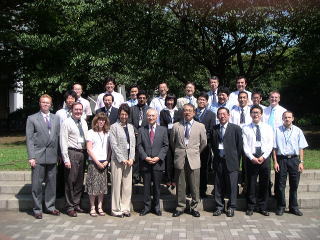| Title |
Speaker |
Manuscript |
Slide |
| Recap on Day 1 |
Ronald T. Eguchi, ImageCat
Fumio Yamazaki, Chiba University |
|
|
| Remote Sensing, GIS, and Modeling Technologies Enhance the Synergic Capability
to Comprehend the Impact of Great Tsunami Disaster |
Shun'ichi Koshimura, Tohoku University
Masasuke Takashima, Fuji-Tokoha University |
 |
 |
| Geography, Disaster Recovery and Remote Sensing |
Arleen A. Hill, Memphis State University |
 |
 |
| Evaluation of Tsunami Damage in the Eastern Part of Sri Lanka due to the 2004 Sumatra Earthquake Using High-Resolution Satellite Images |
Hiroyuki Miura, Tokyo Institute of Technology |
 |
 |
| SAR Data Calibration by Urban Texture: Application for the Bam Earthquake using Envisat Satellite ASAR Data |
Babak Mansouri, UCI/ImageCat/MK Beton |
 |
 |
| Preliminary Results in Development of an Object-based Image Analysis Method for Earthquake Damage Assessment |
T. Thuy Vu, EDM/NIED |
 |
 |
| Katrina's Fury: An Assessment of Environmental Data Fusion for Rapid Large Scale Hurricane Damage Assessment Using Moderate Resolution Imagery |
Richard Watson, Theresa R. Watson, Enrique L. Montano, and Crystal M. Krause,
CREATE at the University of New Mexico |
|
 |
| Airborne and spaceborne images for earthquake damage detection of expressways and buildings |
Yoshihisa Maruyama, Chiba University |
 |
 |
| Infrastructure Inventory Compilation Using Single High Resolution Satellite Images |
Pooya Sarabandi, Stanford University |
 |
 |
| Characteristics of Remote Sensing Images for the 2004 Niigata-ken Chuetsu
Earthquake |
Masashi Matsuoka, EDM/NIED |
 |
 |
| An urban Damage Scale based on Satellite and Airborne Imagery |
Ronald T. Eguchi, ImageCat
|
 |
 |
| Research Needs for Disaster Response - Group Discussion |
Richard Watson, University of New Mexico |
|
|
| Workshop Resolutions |
Ronald T. Eguchi and Fumio Yamazaki |
|
|
| Closure |
Fumio Yamazaki and Masanobu Shinozuka |
|
|



